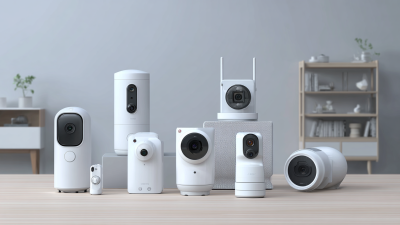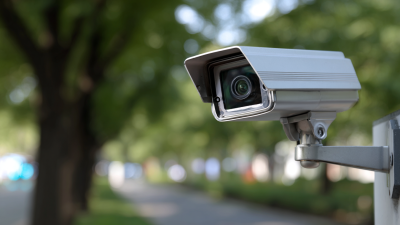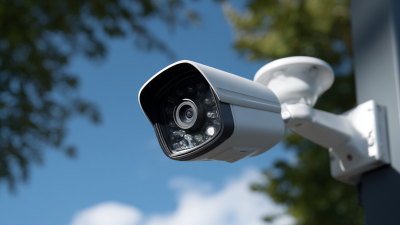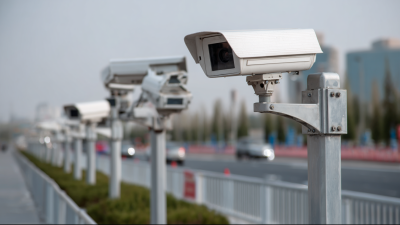
As the demand for robust remote surveillance solutions continues to grow, 4G Security Cameras have emerged as a pivotal tool for both residential and commercial security. According to Jane Smith, a leading expert in the field of surveillance technology, “4G Security Cameras not only provide the freedom of mobility but also enhance real-time monitoring capabilities, making them essential for today’s security needs.” This assertion underscores the increasing reliance on wireless technology for effective surveillance, especially in areas lacking traditional broadband internet access.

In 2023, the market for 4G Security Cameras is witnessing significant advancements, offering features such as enhanced video resolution, improved battery life, and user-friendly interfaces. These innovative cameras enable users to keep an eye on their properties from anywhere in the world, ensuring peace of mind through active monitoring. As we explore the ten best 4G Security Cameras available this year, it's crucial to consider not only their technical specifications but also their real-world applications and performance in varying environments. With expert opinions guiding our choices, we delve into the options that promise to deliver ultimate remote surveillance efficiency and reliability.
Using 4G security cameras for remote surveillance offers numerous benefits that cater to the needs of modern users. One of the most significant advantages is their ability to operate independently of traditional Wi-Fi networks. This is particularly useful in situations where internet access is limited or unreliable, allowing users to maintain surveillance in various locations, such as construction sites, rural areas, or even during outdoor events. The reliability of a 4G connection ensures that high-quality video feeds can be transmitted in real-time, providing critical information when it matters most.
Additionally, 4G security cameras often come equipped with advanced features like motion detection, night vision, and two-way audio, enhancing their effectiveness for remote monitoring. Users can receive instant alerts on their mobile devices, enabling immediate action if suspicious activity is detected. Moreover, these cameras often include cloud storage options, allowing users to securely access recorded footage from anywhere. This combination of accessibility, real-time monitoring, and advanced functionalities makes 4G security cameras an essential tool for anyone looking to enhance their remote surveillance capabilities in 2023.

When selecting a 4G security camera for remote surveillance in 2023, there are several key features to consider to ensure optimal performance and reliability. First and foremost, look for cameras that support high-definition video streaming. According to a recent report by MarketsandMarkets, the global video surveillance market is projected to reach USD 74.6 billion by 2025, underscoring the growing demand for high-quality visual surveillance. Cameras with a resolution of at least 1080p will deliver clearer images, which is crucial for identifying faces and license plates.
Additionally, consider the camera's battery life and data plan options. Many 4G cameras are equipped with rechargeable batteries that can last up to 12 months. This feature allows for greater flexibility in placement without the hassle of frequent recharging. Furthermore, check the data usage associated with the camera; some models are designed to optimize bandwidth, reducing costs while maintaining quality. Reports indicate that consumers often overlook the importance of data efficiency, which can lead to higher monthly bills.
Tip: Always choose a camera with a robust mobile app that allows you to manage settings, view live feeds, and receive notifications on your smartphone. A user-friendly interface can significantly enhance your surveillance experience, making it easier to monitor your property in real time. Prioritize models that offer features such as two-way audio and cloud storage options for added security layers.
When it comes to ensuring safety and security, 4G security cameras have emerged as an essential tool for remote surveillance in 2023. These high-tech devices provide users with the flexibility to monitor their properties without being tethered to Wi-Fi networks. With advanced features like high-definition video, night vision, and motion detection, the best 4G security cameras offer impressive capabilities that cater to various security needs, whether for residential, commercial, or outdoor settings.
In our review of the top 10 4G security cameras for 2023, we focused on key attributes such as ease of installation, battery life, and video clarity. Many models now come equipped with innovative technology like two-way audio and cloud storage options, which enhance their functionality. Furthermore, the integration of AI technology allows for smarter alerts and real-time notifications, ensuring users are always connected to their surveillance feeds. Each of the selected cameras shines in its reliability and performance, making them excellent choices for anyone looking to enhance their security measures this year.
When it comes to optimizing the performance of 4G security cameras, installation plays a crucial role. According to a report by MarketsandMarkets, the global security camera market is projected to reach $12.66 billion by 2025, which underscores the increasing demand for effective surveillance solutions. To achieve optimal performance, users should ensure that cameras are positioned at strategic angles that provide a clear line of sight to potential intruders while also minimizing obstructions caused by trees, buildings, or other structures.
Additionally, proper network setup is essential for seamless connectivity. A study published in the Journal of Network and Computer Applications indicates that up to 30% of security camera malfunctions are due to insufficient network strength. Therefore, before installation, testing the 4G signal strength at the desired location can significantly enhance the video quality and reduce latency. It’s also advisable to utilize an external antenna to boost the signal when necessary, ensuring your security system remains reliable and efficient even in remote areas.
As we look towards 2025, the landscape of wireless surveillance technology is set for significant advancements, driven by the increasing integration of IoT devices in smart buildings. The global market for wireless industrial IoT sensors is projected to expand dramatically, from an estimated 7.97 billion in 2025 to over 21.49 billion by 2033, reflecting a compound annual growth rate of 13.2%. This growth underscores the essential role of smart technologies in optimizing building operations and enhancing energy management, ultimately resulting in more sustainable urban environments.
Moreover, the integration of AI and edge computing into home security systems will revolutionize how we think about surveillance. This evolution enables advanced features like facial recognition, object detection, and behavior analysis, contributing to smarter and more responsive home security technologies. By harnessing real-time data processing and analytics, future surveillance systems will not only improve security but also facilitate predictive maintenance and smarter interactions with the surrounding environment, paving the way for a comprehensive, interconnected lifestyle.







